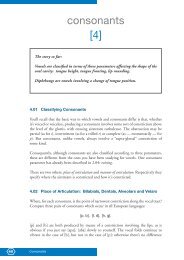PHONETICS MANUAL.indd - HumBox
PHONETICS MANUAL.indd - HumBox
PHONETICS MANUAL.indd - HumBox
You also want an ePaper? Increase the reach of your titles
YUMPU automatically turns print PDFs into web optimized ePapers that Google loves.
Having seen these diagrams, you should be able to sense the high/low difference simply<br />
by saying [i] and [a] to yourself, and feeling the difference in tongue posture.<br />
In some books you’ll find the terms close and open instead of high and low respectively.<br />
But there’s no difference in meaning: a high vowel is the same thing as a close vowel;<br />
a low vowel is the same as an open vowel. High and low are the commonest terms,<br />
and they will be used in most of what follows.<br />
Now the [u] of who’d is also a high vowel. What makes it different in quality from<br />
[i]?<br />
who’d<br />
Fig. 9<br />
It’s not quite so easy to sense the answer just by saying [i] and [u] and trying to<br />
compare the effects. But Fig. 9 should be clear enough: for [u] the tongue is pulled<br />
backwards (“retracted”), in such a way that it’s arched towards the soft rather than the<br />
hard palate. So [u] is a back vowel as well as a high one. Vowels like [i] and [a], by<br />
contrast, are said to be front vowels:<br />
Fig. 10<br />
[i] high + front<br />
[a] low + front<br />
[u] high + back<br />
The [A] of spa differs from each of these three. For [A] the tongue is low (unlike [i]<br />
and [u]), but retracted (unlike [i] and [a]).<br />
spa<br />
Fig. 11<br />
16 Vowels






